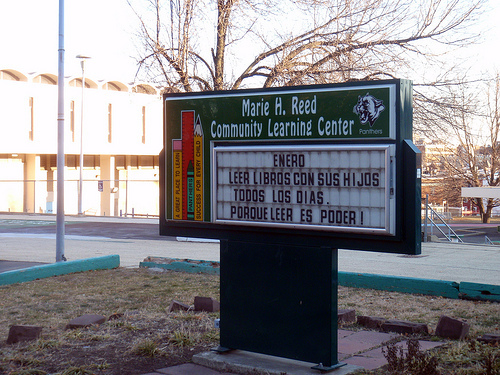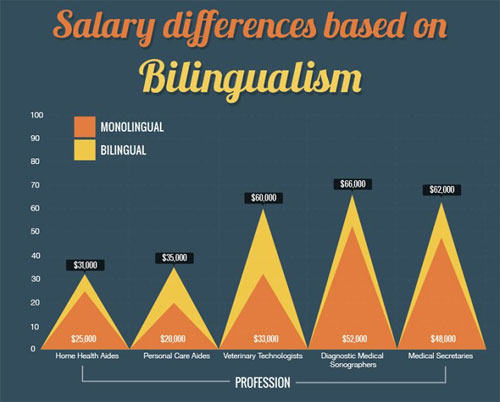Education in multiple languages gives kids a big boost, which means high demand for DC’s programs
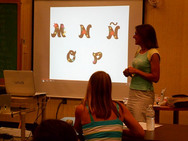
Photo by sussex.library on Flickr.
Seven DC public schools and six charters teach children in not just one language, but two. It’s an approach that helps native and non-native English speakers, poor and affluent children alike, the latest research shows. But 13 schools are far from enough to meet the demand.
Children pick up languages very quickly. When you think about it, it’s quite an amazing feat to learn one language when you know zero. Their brains can easily pick up languages in the early years, and in much of the world, children learn multiple languages.
Traditionally, US education doesn’t start other languages until middle school, when the window of best opportunity has closed. A once-a-week Spanish lesson isn’t enough either. But a few DC schools offer true immersion, where many lessons are in a language besides English.
Unfortunately, those programs are so successful that some boast among the longest waiting lists in the city. With few such programs concentrated in even fewer neighborhoods, it’s not an option open to everyone.
What is immersion and where is it in DC?
To be an “immersion,” “dual language,” or “bilingual” school, at least half of the instructional time has to happen in a language other than English, even for kids who are native English speakers. This isn’t the same as teaching “foreign language” or “world language” as a separate subject; instead, students might have their math or history lessons in Spanish, or Chinese, or another language depending on the school.
DC Public Schools has seven bilingual elementary schools, all in Spanish: Oyster-Adams in Woodley Park, Marie Reed in Adams Morgan, Bancroft in Mount Pleasant, Powell in Columbia Heights, Bruce-Monroe in Park View, Cleveland around U Street, and Tyler in Capitol Hill.
A number of charter schools also teach in two languages: DC Bilingual in Columbia Heights, Latin American Montessori Bilingual (LAMB) in Brightwood and Brookland/Woodridge, and Mundo Verde in Truxton Circle all teach Spanish. There’s also Sela, which teaches Hebrew in the Riggs Park area; Stokes, in Brookland, which teaches in French and Spanish; and Yu Ying, near Catholic University, in Mandarin Chinese.
The only private immersion school in DC I’m aware of is the Washington International School, which offers Spanish, French, or a small Dutch program only for native speakers. Some private preschools teach dual language and some teach only in one. CommuniKids runs a Spanish-immersion preschool in Tenleytown as well as both French and Spanish in Falls Church and Loudoun.
When my family took a tour, the CommuniKids administrators explained that most of their students speak English at home, but they teach entirely in Spanish; kids at that age pick up Spanish very quickly, and the Spanish at school balances out with English at home.
Of course, that’s not a good strategy for schools serving non-English native speakers, such as immigrants. Many of DC Public Schools’s bilingual schools are located in areas with a high percentage of native Spanish speakers (such as Adams Morgan, Mount Pleasant, and Columbia Heights) because many started as a way to help “English language learners” (which was called ESL when I was in school) better participate.
However, according to Vanessa Bertelli of the DC Language Immersion Project, a group advocating for more language immersion education in DC, the latest research shows that immersion helps all students, native and non-native English speaking alike.
Is immersion good for native English speakers?
Once, many people in the US believed that if you spoke to a child in two languages, he or she would learn language more slowly overall. In fact, 30 years ago, some educators discouraged bilingual parents from speaking a language other than English to their children from birth.
Today, psychologists believe there isn’t a disadvantage, and in fact are many advantages, to speaking multiple languages at home.
Bertelli says that new research shows the same for school. According to a longitudinal study of 85,000 North Carolina public school students, in immersion programs where close to half of students speak the partner language, students consistently outperform their peers
by close to two grade levels, regardless of ethnicity, socioeconomic status and home language.
Other studies of immersion programs that don’t start until grades 2-5 “show evidence of a temporary lag in specific English language skills such as spelling, capitalization, punctuation, word knowledge, and word discrimination,” but after a year or two, these gaps disappear and there is no long-term disadvantage in English proficiency.
Some highly educated parents are able to help their children with reading and math at home, but they can’t offer them instruction in another language. I’ve talked to parents in that position who felt that a language immersion program at their local DCPS school could keep them from leaving the system for a high-demand charter or private school, or even moving out of DC altogether.
For lower-income families, the value can be even greater. Start with the overall cognitive benefit: immersion helps close the achievement gap between children of high- and low-income families. Helena Curtain and Carol Ann Dahlberg write that “Children of color, children from economically disadvantaged backgrounds, and English Language Learners make the greatest proportionate achievement gains from foreign language study.”
Further, in an increasingly globalized economy, more and more jobs require other languages. The fastest-growing job categories in DC include health care, where bilingual workers command higher salaries, and hospitality and tourism, where the value of other languages is obvious. And knowing two languages makes it far easier to learn a third, compared to only knowing English.
Unfortunately, there are currently no immersion programs east of the Anacostia River. This may originally have been because there are few native Spanish speakers east of the river, but evidence is growing that immersion is valuable even in schools with few children speaking the relevant language.
Immersion seats are in demand
DCPS is taking steps toward expanding bilingual programs, and immersion charter schools have created new options. However, space at immersion schools is not readily available. In fact, many immersion schools top the charts of the longest waitlists.
For pre-kindergarten at age three, LAMB and Mundo Verde lead the city with the longest waitlists, while three other bilingual charters are in the top 12.

Schools with the longest waiting lists for PK3. Bilingual schools highlighted in yellow. Orange bars are DCPS, blue bars are charters. Graph from District Measured.
For age four, bilingual Oyster-Adams in Woodley Park (and non-bilingual Janney in Tenleytown), which start at age four, both top the list. Yu Ying is the fourth highest among elementary schools which are not west of Rock Creek Park.
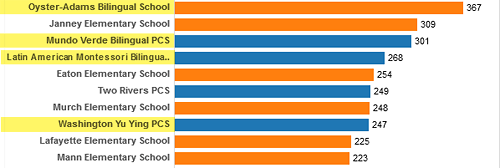
Schools with the longest waiting lists for PK3. Bilingual schools highlighted in yellow. Orange bars are DCPS, blue bars are charters. Graph from District Measured.
Perhaps the best way to gauge the value of immersion is to look at schools which have an immersion pre-kindergarten program alongside an English-only one, such as Marie Reed, Tyler, and Cleveland. The immersion waitlists are on average 2.2 times as long as the non-immersion ones.
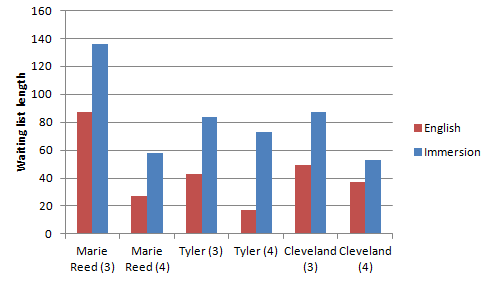
Graph by the author.
Personally, while we are fortunate enough to live in boundary for a school (Ross) which has the second-highest DCPS waiting list at age three, it is not an immersion program. Our daughter is one-quarter Latin American and has been learning Spanish, but not from her parents. She speaks Spanish terrifically for her age, but we fear that in an English-only school she might lose it.
Unfortunately, the long waiting lists for immersion schools, especially nearest to our house, mean immersion may not be a viable option. If DCPS and charters are able to expand immersion programs, perhaps more children can benefit at just the time when their growing brains are ready to learn this valuable skill.
The DC Language Immersion Project is organizing a panel this Thursday, June 11. Greater Greater Washington education editor Natalie Wexler will moderate the panel, which is 7-9 pm at Tyler Elementary School, 1001 G Street SE.

